Heat and hot water are tremendous luxuries afforded to RVers by virtue of the fact that our rigs are homes-on-wheels with all the amenities of a traditional sticks & bricks house (plus wheels)! But there’s more than one way to skin the RV heat & hot water cat, and today we’re looking at the concept of the RV hydronic heating system.
There are pros and cons to hydronic heating systems, of course, but there are some pretty cool features that may interest RVers and even RV manufacturers on the whole. Whether your RV already has a hydronic heating system, or you’re considering buying a new RV that comes with one, you’ll want to learn more about them.
Let’s take a look!
- 1) What is an RV Hydronic Heating System?
- 2) How Does an RV Hydronic Heating System Work?
- 3) Who Makes RV Hydronic Heating Systems?
-
4)
11 Things You Need to Know About RV Hydronic Heating Systems
- 4.1) A Hydronic Heating System Can Pre-Heat a Diesel RV Engine in Cold Weather
- 4.2) An RV Hydronic Heating System Can Heat the RV and its Water While Driving
- 4.3) Hydronic Heating Systems Can Heat RV Storage Bays and Holding Tanks
- 4.4) RV Hydronic Heating Systems Provide Continuous Hot Water
- 4.5) Hydronic Heating Systems Distribute Heat Evenly Throughout the RV
- 4.6) The Heating Burner Is Not Installed in the RV’s Living Space
- 4.7) Heat and Hot Water from Hydronic Systems Are Not Impacted by Elevation
- 4.8) RV Hydronic Heating Systems Are Great Off the Grid or On the Grid
- 4.9) Hydronic Systems are Quieter in the Interior of the RV than Traditional RV Heating Systems
- 4.10) Exhaust and Exhaust Noise Can Be an Issue with Some Systems
- 4.11) Hydronic Heaters May Be Fueled by Diesel, Propane, or Gasoline
- 5) What Are Your Thoughts on RV Hydronic Heating Systems?
What is an RV Hydronic Heating System?
You may have heard of hydronic heating systems that are sometimes used to provide heated floors and/or to heat the living space using baseboard heaters or radiators. You may also know that one of the great benefits of these systems is that they distribute heat evenly.
In general, hydronic systems heat a liquid and then distribute it through tubes, radiating heat throughout an area. Hydronic heating generally offers clean, comfortable well-distributed heat, minimizing cold spots. It’s also an energy-efficient way to provide heat.
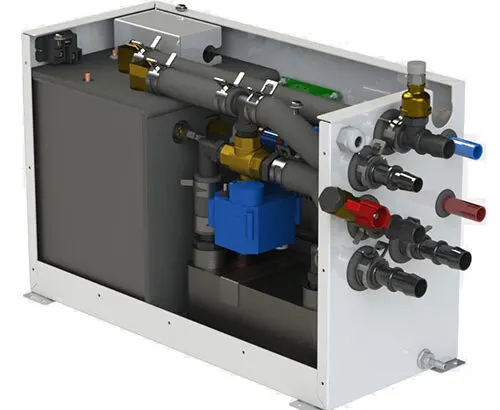
RV hydronic heating systems distribute clean, energy-efficient heat throughout the RV, minimizing cold spots. (Photo credit: Aqua-Hot)
This type of system, when installed in an RV, has several benefits.
Traditional RV furnaces typically burn propane to heat the air, and the heated air is moved through a system of ducts by a blower fan. (For more details, see our post entitled, “How does an RV Propane Furnace Work?”)
Similarly, traditional RV water heaters hold water in a tank and the water is heated either with a propane burner or by an electric heating element. Once heated, that water remains in the tank until it’s used. It’s not the most efficient system because you’ll heat up the entire tank full of water (typically between 6 and 12 gallons) just to wash your dishes or take a shower.
RV hydronic heating systems replace both the RV water heater and the propane furnace. It typically uses a diesel-fired boiler (though it’s also possible for a system to use propane or even gasoline) to provide both instant on-demand hot water as well as heat throughout the RV. An electric heating element is often included as part of the system to provide heat & hot water when the rig is connected to shore power if so desired.
How Does an RV Hydronic Heating System Work?
Hydronic heating systems uses a high-output burner (again, usually diesel-powered, but could also be propane-powered) to heat a liquid antifreeze that’s circulated through insulated tubing using a pump. The hot liquid is pumped to heat exchangers that circulate warm air through a system of small, low-voltage radiator fans situated throughout the RV.
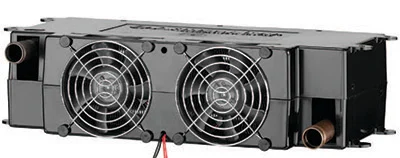
Here you see an example of a heat exchanger that circulates warm air through a series of radiator fans placed in various locations throughout an RV. (Photo credit: Aqua-Hot)
Each of these radiators houses a blower fan to provide forced air heat. In larger RVs, each radiator is usually assigned to a zone, and each zone receives the desired heat.
Coils with water running through them are used to heat water. The coils wrap around the boiler and transport heated water on demand to the RV’s sinks, shower, and appliances as designed in the particular RV.
Depending on what type of RV hydronic heating system is installed, any one of a number of heat sources may be used. But in general, these systems use a combination of engine heat, onboard fuel (most often diesel but could also be propane), and/or shore power (AC electricity).
And again, we’re talking about a single hydronic heating unit that is capable of replacing an RV’s furnace and water heater.
Who Makes RV Hydronic Heating Systems?
Hydronic heating systems specifically for RVs are generally made by one of the following companies:
- Aqua-Hot (several models offering diesel, propane, or even gasoline-powered heating)
- ITR Thermal Research (diesel powered)
- PrecisionTemp (propane powered)
- Alde (propane powered)
Alde systems are more popular in the European market and tend to be designed for small RVs and travel trailers (probably because Europe typically produces smaller RVs in general). But they are expanding into the North American market.
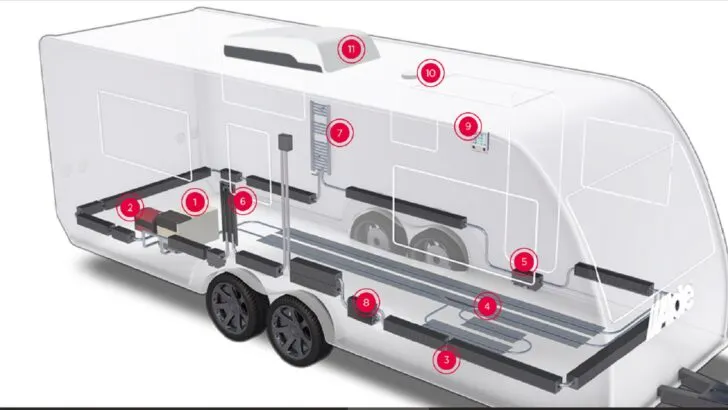
This is a photo rendering of a travel trailer with an Alde hydronic heating system installed. (Photo credit: Alde)
As an example, Aqua-Hot’s model 125D hydronic heating system is designed to provide heat & continuous hot water specifically for diesel Class B RVs, but they also offer models that are capable of providing heat and hot water for larger RVs, with more zones.
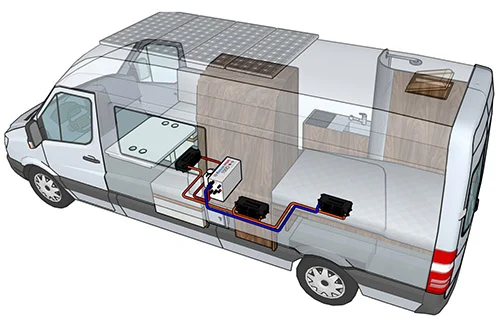
This photo rendering represents an Aqua-Hot 125D hydronic heating system installed in a Class B RV. (Photo credit: Aqua-Hot)
11 Things You Need to Know About RV Hydronic Heating Systems
With all of the basics under your belt, what are the things you need to know about these systems? Here’s a list of 11 things we think are important for any current, or future, RVer who’s rig includes one of these systems.
A Hydronic Heating System Can Pre-Heat a Diesel RV Engine in Cold Weather
A hydronic heating system are often installed with an additional heating loop designed to provide pre-heating to diesel RVs to warm the engine block. This makes it easier (or even possible!) for a diesel engine to start in below-freezing temperatures. It replaces the more standard electric heating element, and provides the additional benefit of being able to provide engine heating in cold temperatures without requiring shore power or a generator.
An RV Hydronic Heating System Can Heat the RV and its Water While Driving
The antifreeze loop noted above can also make it possible for heat from the engine to deliver heat to the interior of the RV or make hot water while the RV is being driven. Typically, using/needing hot water while driving isn’t as big an issue. But being able to use the engine’s waste heat to keep the interior of the RV warm when driving in colder climates is a plus. Dashboard heat doesn’t reach very far back, and on cold days, the rear of a long RV can get quite cold.
Hydronic Heating Systems Can Heat RV Storage Bays and Holding Tanks
Traditional forced-air systems often include an auxiliary outlet (or separate heat source) to keep exterior bays warm in cold weather. Similarly, hydronic heating systems can heat your RV’s storage bays and holding tanks to keep them from freezing.
RV Hydronic Heating Systems Provide Continuous Hot Water
Like an RV tankless water heater, hydronic systems provide continuous on-demand hot water throughout your RV. Just be aware that if both heat AND hot water are required, you may need to ensure that the combustible fuel heat source is engaged, as the built-in electric elements may not be sufficient to keep up with demand.
Hydronic Heating Systems Distribute Heat Evenly Throughout the RV
Typical forced hot air systems can create uneven heat with hot and cold spots throughout the rig, along with a large difference in temperature from floor to ceiling, due to the high-speed and high-volume blast of air they create. By contrast, hydronic heating systems use smaller fans and a gentler flow of air to provide more even heat distribution with fewer and less-noticeable hot or cold spots, and only a very small temperature difference from floor to ceiling.
The Heating Burner Is Not Installed in the RV’s Living Space
Just like with traditional RV furnaces and water heaters, this type of heating system is typically installed in an outside bay or cargo area. Exhaust from the combustion of fuel for heating is directed away from the living space via an exhaust pipe.
In smaller rigs, (vans and Class B RVs, for example), the burner is usually installed on the underside of the van chassis for both noise reduction and exhaust.
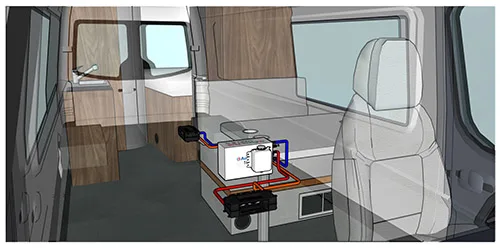
This photo rendering shows a hydronic heating system installed under the dinette area of a small RV. (Photo credit: Aqua-Hot)
Heat and Hot Water from Hydronic Systems Are Not Impacted by Elevation
RV appliances can be affected by high elevation. In the mountains (i.e. at elevation), the decreased oxygen density can result in a pretty significant loss of heat output. The higher you are, the worse it is. Cold nighttime temperatures can freeze water lines and sometimes even water tanks due to the reduced efficiency and heat output. In fact, some RVers who travel high into the mountains in colder weather sometimes empty their fresh and gray tanks and bring along portable water containers.
Some diesel and gasoline RV heaters won’t work well (or at all) if there isn’t sufficient oxygen to burn unless they’re specifically designed for higher altitudes or are fitted with a special high altitude kit or have an automatic adjustment for high-altitude conditions.
However, with a hydronic heating system, you’ll have heat and hot water at any altitude because the system adjusts the oxygen and fuel mixture to optimize the flame for altitudes up to 11,000 feet. (So maybe skip the overnight trip to the summit of Pikes Peak during the winter months?) ????
RV Hydronic Heating Systems Are Great Off the Grid or On the Grid
Hydronic systems use the rig’s onboard fuel for all heating and hot water needs, while also offering the option to use the electrical element when shore power is available. Units burning diesel are often installed on RVs without a propane tank, eliminating a second fuel that needs to be managed/refilled. Plus, diesel tanks on RVs tend to be fairly large, meaning you can easily carry a plentiful supply to suit your heating/hot water needs while camping off-grid.
Hydronic Systems are Quieter in the Interior of the RV than Traditional RV Heating Systems
The combustion unit of an RV hydronic heating system is installed outside the van/RV with its own independent exhaust, while quiet interior fans provide heat inside the rig. Some hydronic systems also offer a “night mode” which provides plenty of heat with an additional noise dampening feature.
Exhaust and Exhaust Noise Can Be an Issue with Some Systems
While quieter in the living space of an RV, the exhaust pipe of a hydronic heating system generally sticks out from the driver’s side, somewhere near the middle of the rig. The exhaust can put off an odor, especially if the burner is running rich (annual maintenance is highly recommended). While this may not be noticeable to you on the inside of the rig, if you’re parked close to other campers, the smell can be problematic. And while it may be quieter on the inside of the rig, there may be exhaust noise outside from some hydronic heating systems.
As a result, some RV owners with hydronic systems use an exhaust stack kit that raises the exhaust higher than the roof of the RV to disburse the noise and smell to a higher level, away from themselves and neighbors.
Hydronic Heaters May Be Fueled by Diesel, Propane, or Gasoline
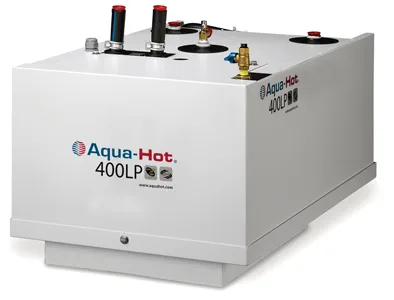
Photo of the Aqua-Hot 400LP, a propane-powered RV hydronic heating system. (Photo credit: Aqua-Hot)
Although most hydronic heating systems require a diesel fuel tank, there are some that use propane as their fuel, and even others that operate using gasoline.
Aqua-Hot, for example, offers several models that use diesel fuel, as well as two models that use propane (250P & 400P), and one model that runs on gasoline (125G).
What Are Your Thoughts on RV Hydronic Heating Systems?
Have you experienced the use of an RV hydronic heating system? If so, we’d love to know all about your experience. Weigh in using the comments section below!
Geek Out with Us Every Week
Join our newsletter to learn about all things RV-related. Every week we offer free tips, tricks, product reviews, and more to our online community of RVers. So, whether this is your first time on the road or you’re a seasoned expert, we’d love for you to geek out with us!


Jim
Sunday 18th of June 2023
We have Aldi in our Classic 33 Airstream. Very happy. Takes a few minutes to get the water warming, but then the continuous flow of hot water is incredible. Also, it keeps about 2.5 gallons of water heated at all times, enough for dishes. Heating the rig is just as easy, and, yes, very evenly distributed. Very happy with the system.
Daniel
Saturday 17th of June 2023
Thank you for the info, therefore do you have an annual maintenace video that it can show me how to carried out my maintenance on a aquahot 400D. Cheers,
steve fitzgerald
Wednesday 17th of August 2022
how much do u think it would cost to have one retrofitted in a class A 40 ft. like maybe the 400D. and do u know anyone who does this??? thanks
TheRVgeeks
Wednesday 17th of August 2022
That’s an interesting question, Steve. Can’t say that we’ve ever heard of anyone retrofitting a hydronic heating system into a coach. There are a lot of hydronic/coolant lines to be run to supply heat to registers, plus wiring the control wires for the fans in those registers. It would be a fairly monumental project.
George B
Saturday 18th of June 2022
Wondering how this systems compares to a Truma Combi system, especially regarding efficiency and fuel flexibility.
TheRVgeeks
Saturday 18th of June 2022
That's a good question, George. The Truma Combi is a sweet little unit (we've had it as the combined forced hot air heat and hot water system on virtually ALL of our Class B+ style RVs we've rented overseas and have really liked it). Would love to see some kind of comparison between that and any of the hydronic systems, too!
John S.
Saturday 18th of June 2022
"Hydronic heating systems specifically for RVs are generally made by either Aqua-Hot or Alde."
Do you mind a small correction? The Oasis diesel hydronic heating system is also made specifically for the RV market. I have been to the head office/manufacturing plant in Richmond to get the annual service kit many times. (You should visit them for a quick tour one day.) https://itrheat.com/products/rv-trailer-mobile-heating-system/
I really like the Oasis system installed in my Newmar for all the reasons you point out in this post. If plugged into shore power one feature we use often is the electric heating elements. When the nighttime temps drip to 'coolish' I set the furnace zones to heat using the hydronic system heating coils. This is enough to provide enough heat all night. For hot showers we always use diesel to avoid going from hot to lukewarm.
One last point: at our RV resort many owners have had maintenance issues with their Aquahot systems. The Oasis owners, not nearly so much. Some of the differences: the combustion chamber in the Oasis is stainless steel and all hoses and fittings are the best available.
TheRVgeeks
Saturday 18th of June 2022
Thanks, John (article's already been updated with a couple brands we neglected to list). Good to hear more first-hand experiences with the Oasis. We've also heard about it being more reliable than the Aqua-Hot... which, we assume, is why Newmar chooses it! ????